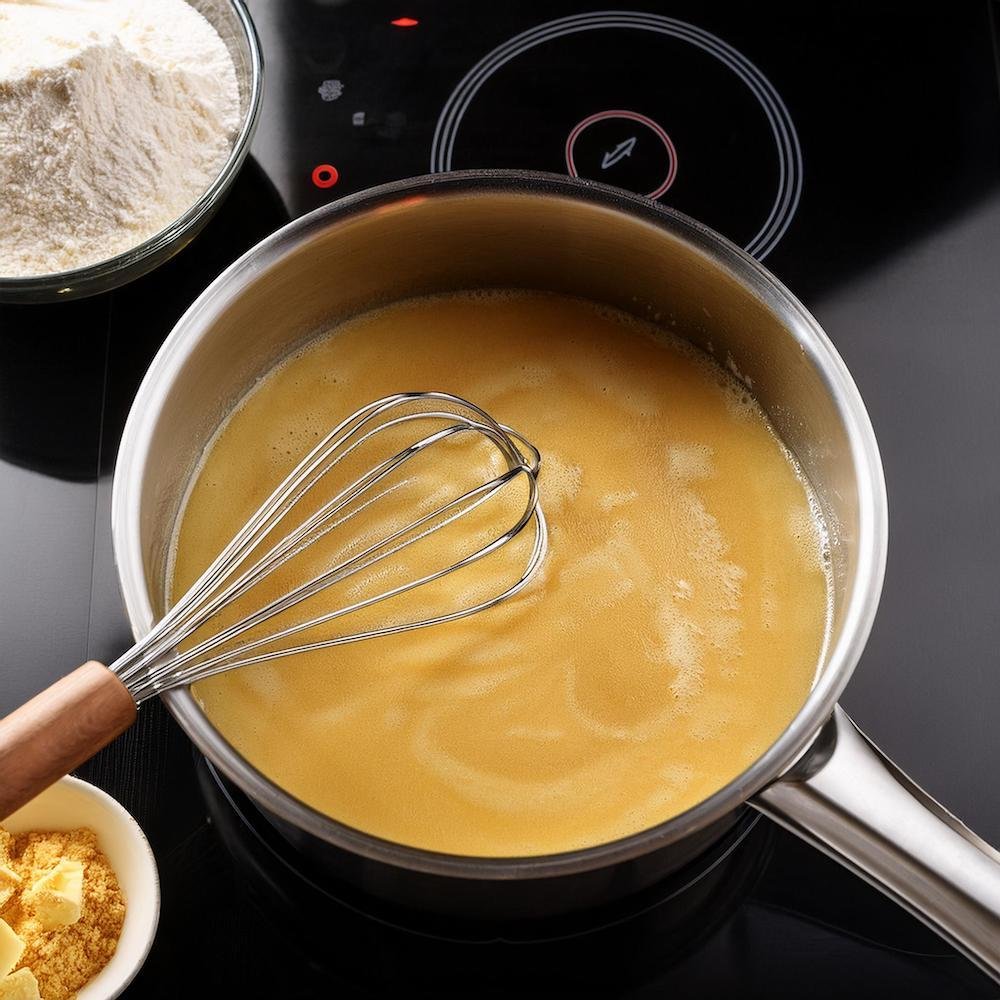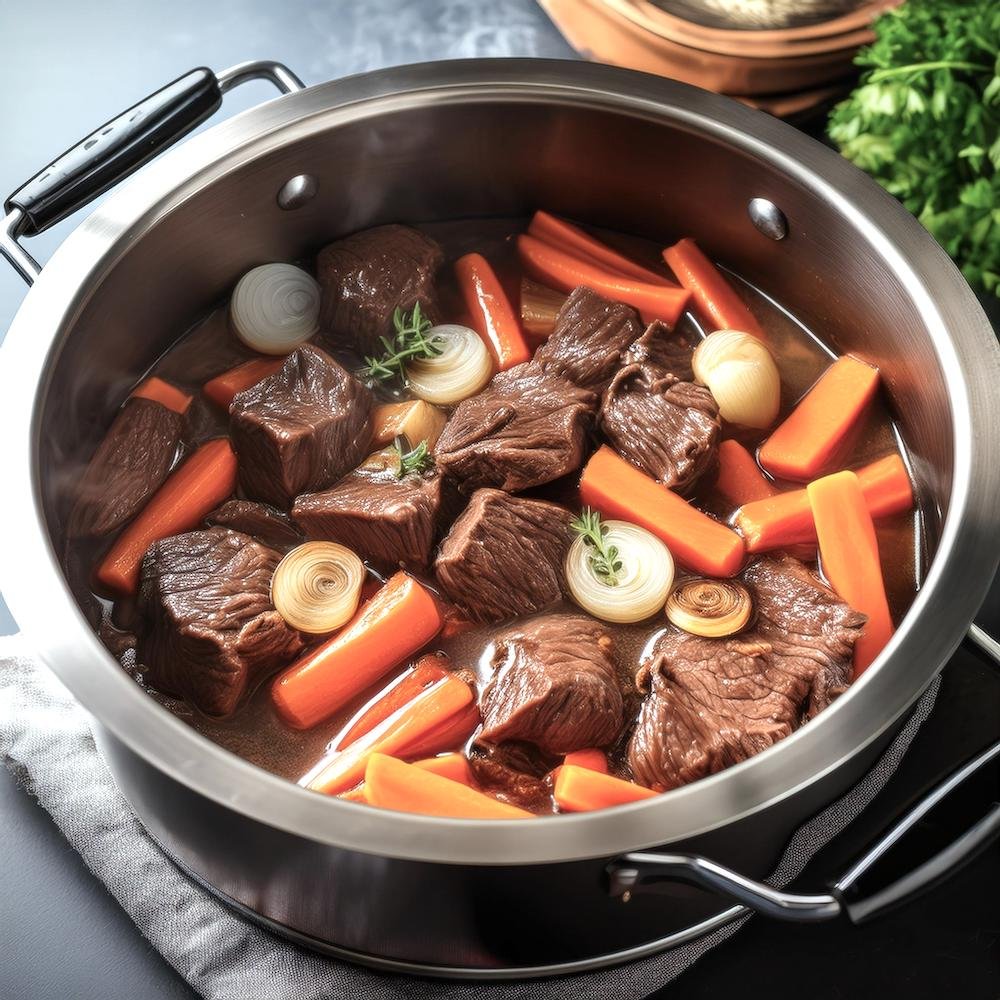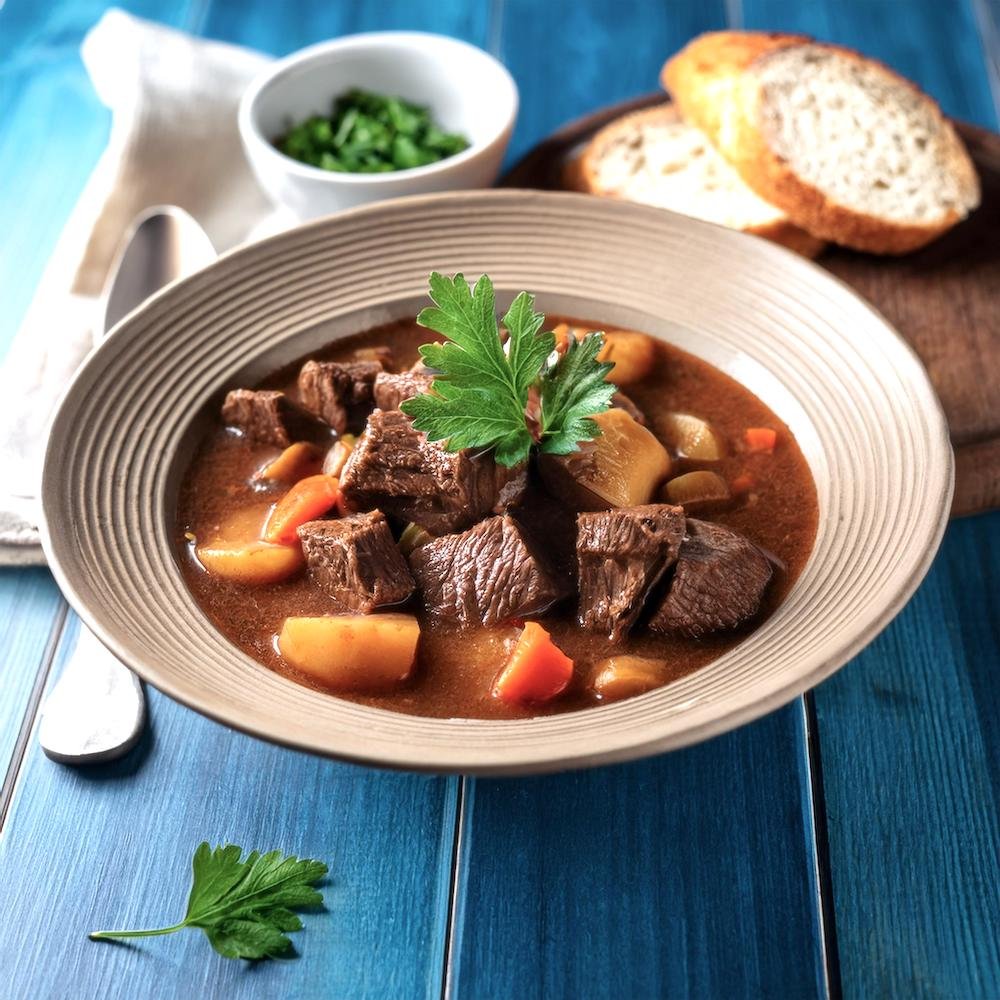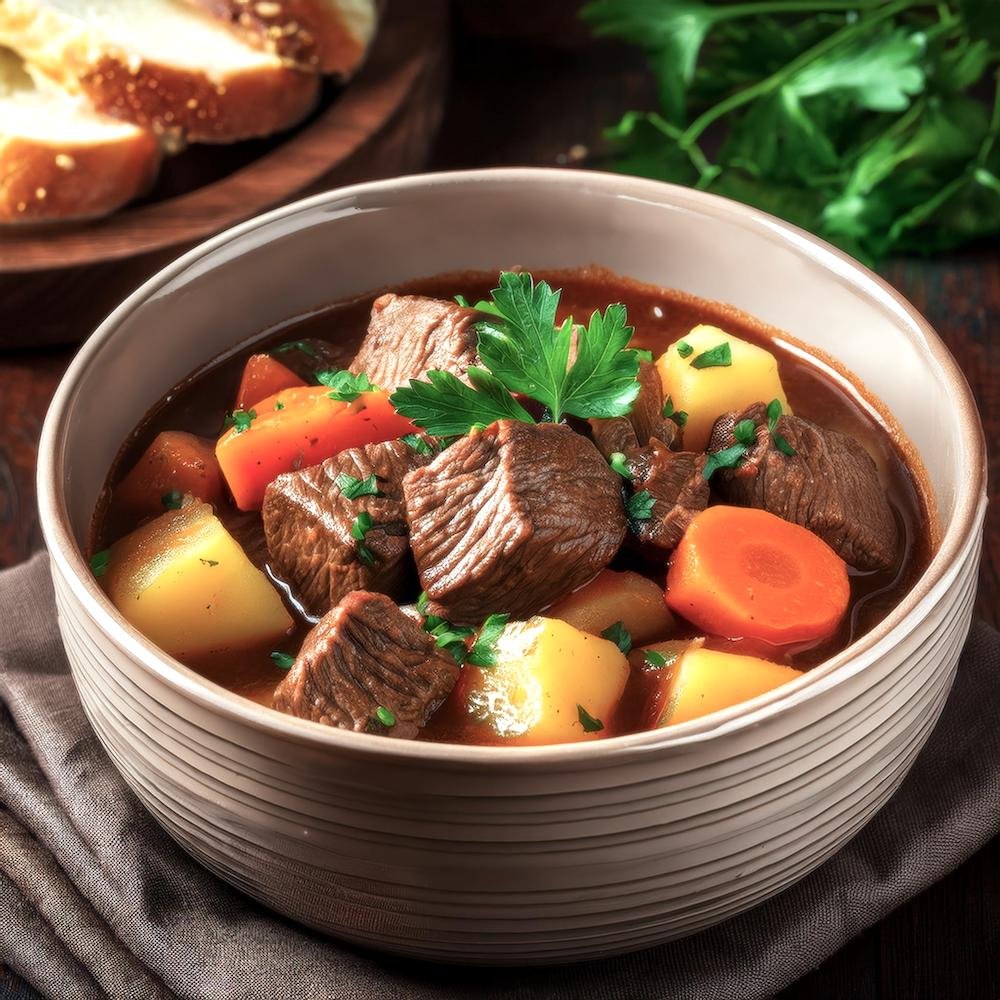Introduction
Can You Use a Roux for Beef Stew? Beef stew is a hearty, flavorful dish that’s loved for its tender meat, rich broth, and savory vegetables. But what if you want to take your beef stew to the next level with a thicker, creamier consistency? This is where a roux comes in.
A roux, a simple mixture of fat and flour, is a game-changer in cooking. When added to beef stew, it not only thickens the broth but also enhances the flavor and texture, giving the dish a velvety richness. In this guide, we’ll explore why roux works so well in beef stew, how to use it effectively, and tips for achieving the perfect consistency.
What Is a Roux and How Does It Work?
Roux is a classic culinary technique used to thicken sauces, soups, and stews. It’s a versatile addition to any cook’s repertoire and is particularly effective in elevating beef stew.
1. Definition of Roux
- What It Is: Roux is made by cooking equal parts fat (such as butter, oil, or lard) and flour together to form a paste.
- Purpose: It acts as a thickening agent, giving dishes a creamy, smooth texture.
2. The Science of Thickening with Roux
- How It Works:
- Cooking flour with fat eliminates its raw taste and activates its thickening properties.
- When combined with liquid (like broth in beef stew), the roux forms a silky, thick sauce.
- Stages of Roux:
- White Roux: Cooked briefly; mild flavor, ideal for creamy soups.
- Blond Roux: Light golden color; slightly nutty flavor, perfect for stews.
- Brown Roux: Darker and richer; adds a deep, robust flavor to dishes.
3. Why Roux Is a Great Choice for Beef Stew
- Enhances Texture: Thickens the broth, making the stew more satisfying.
- Adds Depth: The fat in roux enriches the overall flavor profile.
- Customizable: Adjust the roux’s cooking time and ingredients to suit your stew’s flavor.
Pro Tip: Choose the Right Roux for Your Stew
- A blond roux is often the best choice for beef stew, as it balances a light nutty flavor with effective thickening power.
Benefits of Using a Roux in Beef Stew
Incorporating a roux into beef stew is an excellent way to elevate the dish. It not only enhances the flavor but also transforms the texture, making your stew more enjoyable and visually appealing.
1. Adds Richness and Depth of Flavor
Why It Works
- The fat in the roux imparts a buttery, savory flavor that complements the natural umami of beef.
- As the roux cooks, it develops nutty, toasty notes that deepen the overall flavor profile of the stew.
Result
- A more complex and satisfying taste that pairs beautifully with the hearty ingredients of the stew.
2. Creates a Velvety Texture
Why It Works
- Roux thickens the broth, creating a smooth, creamy consistency that clings to the beef and vegetables.
- This texture enhances the eating experience, making each bite feel indulgent and substantial.
Result
- A luxurious, restaurant-quality stew that feels rich and comforting.
3. Makes the Stew Visually Appealing
Why It Works
- Roux gives the stew a consistent, glossy appearance by binding the liquids and fats together.
- It prevents the broth from separating, ensuring the dish looks as good as it tastes.
Result
- A picture-perfect bowl of beef stew that’s as enticing to the eyes as it is to the palate.
4. Versatility and Customization
Why It Works
- Roux can be tailored to your preferences, from the type of fat used to the depth of color you want to achieve.
- You can also adjust the thickness by controlling the amount of roux added to the stew.
Result
- A highly adaptable thickening method that works for various beef stew styles, from classic to fusion-inspired recipes.
Pro Tip: Enhance the Roux Flavor
- For a richer stew, consider adding aromatics like garlic or herbs to the roux as it cooks. This extra step infuses even more flavor into the base.
Step-by-Step Guide to Adding a Roux to Beef Stew

Using roux in beef stew is straightforward but requires proper technique to achieve the best results. Here’s a detailed guide to incorporating roux into your stew for a thick, velvety consistency.
1. Preparing the Roux
Ingredients
- 2 tablespoons butter (or your preferred fat)
- 2 tablespoons all-purpose flour
Steps
- Melt the Butter: Heat butter in a small saucepan over medium heat until fully melted.
- Add the Flour: Gradually sprinkle in the flour while whisking continuously.
- Cook the Roux:
- For beef stew, aim for a blond roux—cook the mixture for 3–5 minutes until it turns a light golden color.
- Stir constantly to prevent burning and ensure even cooking.
2. Preparing the Stew Base
Steps
- Sear the Beef: Brown the beef in a large pot to build flavor. Remove and set aside.
- Sauté the Vegetables: Cook onions, carrots, and celery in the same pot until softened.
- Add Broth or Stock: Pour in beef stock and scrape the bottom of the pot to deglaze, incorporating all the browned bits for extra flavor.
3. Incorporating the Roux
Steps
- Temper the Roux:
- Remove a ladle of hot broth from the stew and slowly whisk it into the roux.
- This step prevents the roux from clumping when added to the stew.
- Add to the Stew: Gradually stir the tempered roux into the pot of stew.
- Simmer and Thicken: Let the stew simmer for 10–15 minutes, stirring occasionally, as the roux works its magic to thicken the broth.
4. Adjusting the Consistency
Too Thin?
- Add more roux by repeating the preparation process in smaller quantities.
Too Thick?
- Stir in extra broth or water, a little at a time, until the desired consistency is reached.
5. Finishing Touches
Season to Taste
- Adjust salt, pepper, or other seasonings as needed.
- Optional: Add a splash of Worcestershire sauce or red wine for additional depth.
Garnish and Serve
- Garnish with fresh parsley or thyme and serve the stew warm with crusty bread or over rice.
Pro Tip: Make the Roux Ahead of Time
- Roux can be prepared in advance and stored in the refrigerator for up to a week or frozen for longer storage. This makes it easy to add richness to your beef stew at a moment’s notice.
Common Mistakes to Avoid When Using Roux

While using roux can transform a beef stew into a velvety, rich dish, certain missteps can compromise the results. Avoid these common pitfalls to ensure your stew turns out perfectly every time.
1. Overcooking the Roux
Why It Happens
- Cooking roux for too long can result in a burnt taste and dark color that might overpower the stew.
How to Avoid
- For beef stew, aim for a blond roux by cooking it to a light golden color (about 3–5 minutes). Stir constantly to prevent scorching.
2. Adding Roux Too Quickly
Why It Happens
- Incorporating roux directly into the stew without tempering can cause clumps, making the sauce uneven.
How to Avoid
- Always whisk a ladle of hot broth into the roux before adding it to the stew. This step helps the roux dissolve smoothly.
3. Using Too Much or Too Little Roux
Why It Happens
- Adding too much roux can make the stew overly thick and pasty, while too little may not achieve the desired consistency.
How to Avoid
- Follow a general guideline of 2 tablespoons each of butter and flour for every 4 cups of liquid. Adjust gradually as needed.
4. Neglecting to Balance Flavors
Why It Happens
- Roux can mask or dilute the stew’s flavors if additional seasonings aren’t adjusted after thickening.
How to Avoid
- After adding roux, taste the stew and adjust the seasonings. Add a pinch of salt, pepper, or an umami booster like Worcestershire sauce or soy sauce if needed.
5. Skipping the Simmering Step
Why It Happens
- Adding roux without sufficient simmering time can leave a raw flour taste in the stew.
How to Avoid
- Let the stew simmer for at least 10–15 minutes after incorporating the roux to allow the flour to fully cook and integrate.
6. Not Matching the Roux to the Stew’s Flavor
Why It Happens
- Using the wrong type of roux (e.g., a white roux for a bold beef stew) can result in an unbalanced flavor profile.
How to Avoid
- Opt for a blond or brown roux to complement the robust flavors of beef stew.
Pro Tip: Start Small and Build Up
- If you’re unsure about the amount of roux needed, add it in smaller increments, allowing the stew to simmer and thicken before deciding if more is necessary.
Variations: Creative Uses of Roux in Stews
Roux is a versatile ingredient that can adapt to a variety of stew styles and flavor profiles. By experimenting with different ingredients and techniques, you can customize your roux to suit diverse cuisines and dishes.
1. Cajun-Style Roux for Spicy Stews
How to Make It
- Cook the roux longer, until it reaches a deep brown color for a nutty, bold flavor.
- Add Cajun spices like paprika, cayenne, and thyme to the stew for a spicy kick.
Best Served With
- Andouille sausage, chicken, or seafood to create a hearty gumbo-style stew.
2. Japanese-Style Roux for Beef Stew
How to Make It
- Use butter or neutral oil for the fat base, and incorporate soy sauce, mirin, and a touch of miso into the roux.
- For an authentic touch, combine the roux with dashi broth.
Best Served With
- Tender beef chunks, carrots, and potatoes over steamed rice for a Japanese comfort food twist.
3. Miso-Infused Roux for Umami-Rich Stews
How to Make It
- Add a tablespoon of miso paste to a blond roux for an umami boost.
- Use vegetable or chicken broth to complement the miso’s earthy flavors.
Best Served With
- Vegetables like shiitake mushrooms, bok choy, and daikon radish.
4. Wine-Based Roux for European Stews
How to Make It
- Deglaze the pan with red wine after cooking the roux to infuse it with a rich, tangy flavor.
- Add fresh herbs like thyme, rosemary, and bay leaves to the stew for a French-inspired dish.
Best Served With
- Beef, lamb, or veal, paired with crusty bread or mashed potatoes.
5. Dairy-Free Roux for Light Stews
How to Make It
- Replace butter with olive oil, coconut oil, or vegan margarine to make a roux suitable for dairy-free diets.
- Use vegetable or coconut milk-based broth for a creamy but light consistency.
Best Served With
- Lentils, chickpeas, or tofu for a vegan stew option.
6. Herb-Infused Roux for Freshness
How to Make It
- Mix minced fresh herbs like parsley, dill, or cilantro into the roux during the final minutes of cooking.
- Use chicken or vegetable stock for a lighter base that allows the herbs to shine.
Best Served With
- Chicken or turkey, paired with spring vegetables like peas and asparagus.
Pro Tip: Combine Roux with Cultural Cuisines
- Pair the roux with seasonings and ingredients from your favorite cuisine, such as turmeric for Indian-style stews or paprika for Hungarian goulash.
Should I make a roux for beef stew?
Yes, a roux enhances beef stew by thickening the broth, adding richness, and improving the texture. It’s perfect for those who prefer a creamy consistency.
Can you use a roux in a slow cooker?
Yes, add the roux in the last 30–40 minutes to prevent over-thickening. Whisk it with hot broth first to ensure smooth integration.
Does stew have roux?
Not all stews use roux, but it’s common in Japanese and Cajun-style stews for added thickness and flavor. Western stews often rely on reduction or cornstarch.
How to use jar roux for stew?
Scoop the jar roux, dilute with hot broth, and whisk until smooth. Stir into the stew and simmer for 10–15 minutes to thicken.
Suggested Internal Links for:
- Beef Chuck Eye Steak
Explore how to use beef chuck for hearty and flavorful dishes like beef stew. - What is Beef Chorizo?
Learn about adding beef chorizo to stews for a unique flavor twist. - What’s the Best Way to Cook Chuck Eye?
Discover cooking tips for chuck cuts, perfect for stew meat preparation. - What Meat Goes Best with Tarragon?
Enhance your beef stew with the aromatic addition of tarragon. - What is the Difference Between Creme Brulee and Custard?
A unique exploration of roux-like bases in different recipes.
Conclusion

A roux is a simple yet transformative addition to beef stew, enhancing its flavor, texture, and appearance. Whether you’re making it from scratch or using a jarred version, incorporating roux helps achieve a velvety, rich consistency that takes your stew to the next level.
By following the steps and avoiding common mistakes, you can create a restaurant-quality dish perfect for family dinners or special occasions. So, why not try adding roux to your next pot of beef stew? Happy cooking!
Discover more mouthwatering recipes on our Web Site ! Stay connected and get inspired by following us on Facebook, Instagram, Pinterest, and Twitter for the latest updates!
